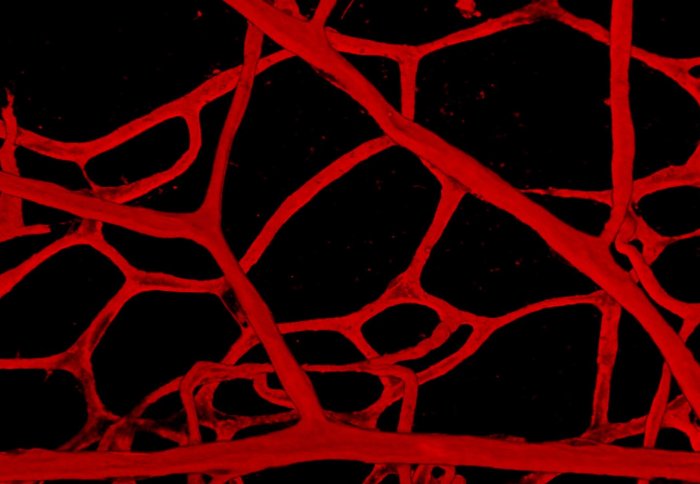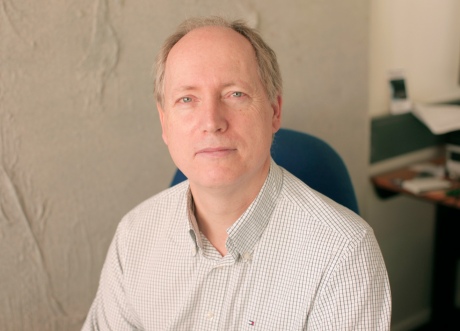

Understanding the vasculature and how it contributes to disease is a joint effort, involving expertise in medicine, physics and engineering.
The heart is often considered the workhorse of the cardiovascular system. However, the heart couldn’t do its job without the complex vascular system that transports oxygen and nutrients around our body. The four major types of blood vessels – arteries, veins, capillaries and lymphatics– all work together in a system known as the vasculature.
The launch of Imperial’s Vascular Science Network aims to harness the multidisciplinary nature of vascular science by drawing on the expertise of researchers from across the College.
Imperial’s Ellyw Evans spoke to Professor Dorian Haskard, who heads the new Network, to find out more.

What led to the formation of this Network?
The vasculature is of obvious importance to many aspects of mammalian biology and underlies many diseases. This area of research is truly crosscutting – it has a strong interface with medicine, engineering, and natural sciences – and so it does not sit exclusively in a particular Faculty or Department. The divisional structure of the College does not always promote collaboration and interdisciplinary research. Imperial has an excellent track record of research in vascular science but in places this research is somewhat fragmented. The Network aims to join up the loose connections.
What benefits does the Network hold for the College?
Many! Firstly, it increases the external visibility of our vascular research and enables Imperial to better present itself as a world-leader in the field. Having a Network provides benefit when applying for funding, as it shows that our researchers are in an outstanding environment for vascular research rather than sometimes working in relative isolation. The Network will also be a good shop window for recruiting future researchers – at both staff and student level.
What does the Network mean for those in it?
I am hoping that the Network will create a strong sense of community within Imperial working on blood vessels.
– Professor Dorian Haskard
Through creating a Network, researchers who have an interest in vascular science – of which there are many – are brought under one umbrella. Seminars and symposiums will be a key part of the Network, which will provide opportunities for researchers from different Faculties to meet in the hope of sparking conversations leading to collaboration. The Network also provides a way of disseminating success which our new website will showcase. Over time this will create an archive of our achievements in vascular science.
How will a Network change the way of working for those in it?
I think it’s very much ‘you get out what you put in’. Interfacing with scientists outside your own discipline can alter how one sees things and bring enormous benefit. However, the Network is not prescriptive – it can only provide opportunities.
Has the Network been a long time in the works?
No, quite the opposite! The call came out in the middle of last year. In only six weeks, we attained over a hundred names of independent researchers which was a promising start. There is a certainly a real buzz about the Network and the level of enthusiasm is very encouraging as people see that it will fill an unmet need.
How do the Network's members reflect the College?
I have tried to include everyone into the Network that has an interest in vascular science. It’s not surprising that our current membership is dominated by the Faculty of Medicine, as it is primarily a biological area. However, about one-third of our members work in engineering, imaging and big data. Like any network, there will be an inner circle who regard vascular science as central to their work and adjuncts who regard vessels as more peripheral to their research focus.
How will the Network support early career researchers?
My vision for the network is that it should be non-hierarchical – first names only! Removing the hierarchical boundaries will encourage early career scientists, offering them opportunities to be involved in the steering group. A particular aim of the Network is to help bring on the future leaders in the field, not just at Imperial but globally.
Which diseases will the network’s research be relevant to?
Blood vessels are absolutely crucial for almost everything in the mammalian body so vascular science is of interest to many diseases. These include coronary heart disease, cerebrovascular disease, peripheral vascular disease, aneurysms and vasculitis. The vasculature also plays an important role in the spread of cancer and infection.
What’s aeronautics got to do with our blood vessels?
This is a good example of interdisciplinarity within the Network. Mechanical forces due to blood flow are of immense importance in driving arterial disease. Computational fluid dynamic expertise, such as is found in aeronautics, can help model patterns of blood flow that stimulate inflammation in arteries and ultimately lead to heart attacks and strokes. Abnormal blood flow can also lead to the failure of surgical grafts and understanding fluid dynamics can make a great contribution to vascular surgery by improving graft design.
Is there a particular project in vascular science that you are excited about?
Research that I am personally interested includes the molecular imaging of blood vessels. Dr Ramzi Khami, a cardiologist, and I are designing antibodies to which we can attach light-emitting dyes. Once injected, these can target and identify particular molecules in inflamed arteries and “report” on disease. The aim is to move beyond imaging of blood vessel structure towards imaging biological activity and thereby inform therapeutic decision-making.
What are your personal hopes for the Network?
I am hoping that the Network will create a strong sense of community within Imperial working on blood vessels. Eventually, I would like to see people creating groupings that may lead to new research centres that are self-sustaining and able to secure external funding. I hope the Network will act as an interface to similar organisations in other world-leading universities and foster national and international interactions. I am also hoping successors emerge with the enthusiasm for and interest in sustaining and preserving the Network - I don’t want to run it forever!
Please contact Dorian Haskard if you would like to be involved and are not already on the circulation list. The Vascular Network launch meeting will be held on 26 March.
Article text (excluding photos or graphics) available under an Attribution-NonCommercial-ShareAlike Creative Commons license.
Photos and graphics subject to third party copyright used with permission or © Imperial College London.
Reporter

Ellyw Evans
Faculty of Medicine Centre

Contact details
Email: press.office@imperial.ac.uk
Show all stories by this author




Leave a comment
Your comment may be published, displaying your name as you provide it, unless you request otherwise. Your contact details will never be published.